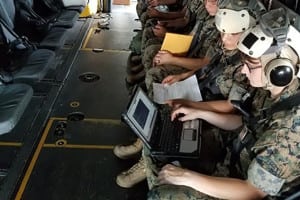The Marine Corps’ plan to redesign its force by 2030 will include divesting from legacy communications equipment and overhauling its tactical network to enable new, lighter formations and littoral regiments.
Ken Bible, the Marines’ deputy chief information officer, told attendees during a virtual AFCEA event the force design effort will require new industry solutions that enable distributed maritime operations and the ability to conduct littoral operations in contested environments.

“There are a lot of opportunities that are presented by this force design effort and by the direction that we’re heading. I think it’s important for us to realize that we’re willing to accept near-term risk in order to achieve the force that we need for the future. So you’ll see some traditional systems probably not get funded, things that we’ll give up,” Bible said.
The force design plan, released in March, detailed plans to eliminate tank battalions and cut artillery cannon batteries, while massively boosting investments in long-range precision fires and unmanned systems, to reshape for future challenges against peer competitors such as China (Defense Daily, March 24).
Bible noted that divestiture decisions will include legacy command and control systems, such as the COC FoS communications platform.
“We’re trading artillery, cannons and tanks in order to get after command and control modernization, electronic warfare, alternatives for position, navigation and timing, long-range fires. These are some pretty profound changes in the force,” Bible said.
Brig. Gen. Lorna Mahlock, the Marines’ CIO, is working through a network modernization plan to guide to align with the force design effort, according to Bible.
Bible said the network modernization effort will include seeking industry solutions for advanced analytics at the tactical edge and communications equipment capable of surviving in contested environments.
“In many cases, we’ll have to assume we cannot access the traditional communications paths by SATCOM and even in the RF realm,” Bible said.
The Marine Corps has said it’s planning to potentially shift $12 billion from low priorities toward its effort to redesign the force by 2030 (Defense Daily, March 27).
“We’ve gone through the force design. We’ve laid out the structures we need to go conduct the fight. We’ve made some trades in terms of what types of systems we believe we need to have for the fight. And now we head into force development about what these systems need to be and how we align the money to actually get the systems we need,” Bible said.